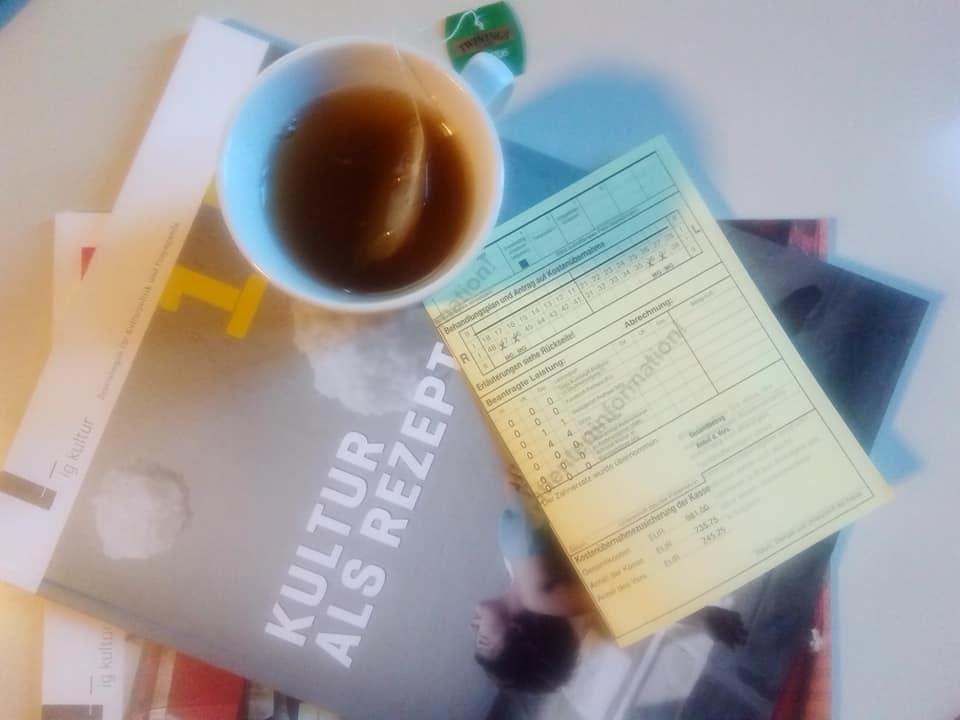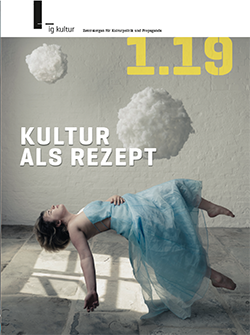Arts on Prescription: A New Kind of Medicine
‘Arts on prescription’ is a term used to describe interventions which use the arts and culture to promote healthy behaviour and aid recovery. A recently published WHO report outlines the benefits of arts-based interventions as low-risk, highly cost-effective, and holistic options for complex problems, often with no medical solutions.

*** Dieser Artikel ist auch auf Deutsch verfügbar ***
‘Arts on prescription’ is a term used to describe interventions which use the arts and culture to promote healthy behaviour and aid recovery. Arts on prescription are forms of complex, multi-modal interventions, and are part of an approach which advocates wider treatment options in response to what are non-medical difficulties. Moreover, many medical problems are caused or exacerbated by social and political determinants, thus arts on prescription represents a culture shift in how we engage with, rather than “treat”, people and their difficulties. As such, this approach highlights the drawbacks with the medical terminology, showing it to preserve a medical context, which individualises difficulties and risks disempowering the individual rather than enabling agency.
Known broadly as ‘arts and health’, the WHO published a report in November 2019 on the evidence for assets-led innovative options. This reflects a growing multidisciplinary field that has developed over the last 30 years, together with a rapidly expanding evidence base. The practices themselves have been associated with human interconnectivity for 40,000 years. They include many kinds of cultural and creative expression, such as storytelling, decorative art, group drumming, dance and singing. The WHO report outlines the benefits of arts-based interventions as low-risk, highly cost-effective, and holistic options for complex problems, often with no medical solutions.
The WHO report outlines the benefits of arts-based interventions as low-risk, highly cost-effective, and holistic options for complex problems, often with no medical solutions.
Developments in the EU region
Between 2012 and 2019, Finland’s Government led the Five-Year Project between the Ministry of Education and Culture and the Ministry of Social Affairs and Health. Its aim was to embed the arts into everyday healthcare. In 2017, Jensen, Stickley, Torrissen & Stigmar (2017) reviewed current research, practice and policy relating to arts and culture on prescription in Sweden, Norway, Denmark and the UK. The authors concluded that significant developments can be attributed to activities in all countries, and that the UK has played a key role in this expansion in terms of academic research and policy making.
Longitudinal evidence of the positive impact on health outcomes and longevity from the Nordic countries led to the establishment of the UK’s All-Party Parliamentary Group on Arts, Health and Wellbeing. Their Creative Healthreport (2017) arranges evidence along a spectrum from clinical arts interventions to non-clinical participatory arts programmes, and considers the arts impact on health across the lifespan and at multiple levels from the individual, community and public health. The benefits of cultural engagement and participation have been demonstrated to be both preventative and restorative; from programmes aimed at keeping well, to people living with minor ailments, through to contexts such as oncology, dementia, end of life care, and life in prison.
The last few decades have seen significant advances in understanding the social determinants of health, as well as the harmful effects of trauma. Exemplifying this is Bessel van de Kolk’s 2015 book, The Body Keeps the Score, which presents an engaging history of this far-reaching field, emphasising the toll such adversity can have on the body, and how this effects social outcomes throughout the lifetime. Such advances make it increasingly clear that the conventional separation between physical and mental health is harmfully misleading. We can now assert that interventions that support connection, expression and resilience in a mental health context will also benefit physical health – and vice versa.
By moving this approach forward we can make more embodied, or ‘intrinsic’, impacts on the individual, promoting confidence, self-esteem, and a sense of belonging. These features of arts-based strategies capitalise on an individual’s ability to develop new skills, experience achievement and pride which, in turn, fosters hope, and helps shape identity formation. Importantly for therapeutic and healing processes, arts engagement targets the foundations of well-being, unlike medications which are intended to reduce symptoms. In bypassing the need for a specificity, cultural engagement and arts participation can support the mind and body to better tolerate and process stress, inequality, and adversity.
Another advantage of arts on prescription is its range of associated approaches. Creative and cultural activity comprises an almost unlimited selection of versatile tools, with multiple access points, and the space to explore individual preferences, stories and skills. A key intention of this approach is to broaden the available repertoire of strategies available to the public. This has the potential to improve patient choice and engagement, and lesson the burden on healthcare services.
Mental Health Policy in the UK
Demand for mental health services is rising. To adapt, the UK Government have announced several new initiatives. In October 2014, NHS England and the Department of Health jointly published Improving access to mental health services by 2020. Within current policy, common themes include the promotion of resilience and self-esteem, and the importance of building healthy relationships. Social prescribing schemes are supported in government policy with evidence emerging that arts activities provided under these schemes produce positive outcomes.
With regards to children and young people, a recent review discusses the contribution arts activities make to building their resilience. Zarobe & Bungay (2017) report positive effects on self-confidence, self-esteem, relationship building and a sense of belonging. The current national transformation of children’s services, known as the THRIVE model, emphasises assets-led and community approaches. An emphasis on prevention has already led to the increased provision of mental health training in schools: there is clearly a role for the arts in this.
Some Issues
While hundreds of studies have been conducted, reviewers discuss a general lack of methodological rigour. Because the arts sector is not financially or politically equipped to seriously rival medical research, it is vulnerable to claims that the evidence base is weak or “anecdotal”. The knowledge is spread across numerous fields of study, reflecting an interdependent picture of multimodal effects that must be critically considered to be understood effectively. Such limitations reduce the potential impact of findings in evidence-based practice, and more comprehensive systematically conducted research is required to address this.
For commissioners to fund arts options as an adjunct to conventional mental health services the potential of arts on prescription must be proven on their terms. Such progress has been made more likely since the Creative Health report, and the public health experiment known as Devolution in Greater Manchester.
Some Solutions
GMiTHRIVE – is Greater Manchester’s transformation of children’s services, based on the solution-focussed national framework for CAMHS (Child and Adolescent Mental Health Services). It seeks to improve access, patient choice, patient safety, and quality. To this aim, we are working strategically to implement arts-led interventions within and around child and adolescent mental health services. Within the UK, a number of well-established organisations provide programmes of arts activities for children and young people (e.g. Arts and Minds (http://www.artsandminds.org.uk); Start Youth Arts (http://www.startinsalford.org.uk)). GMiTHRIVE is supporting the arts sector to understand and utilise accepted outcome measures, conduct high-quality research, and to report on issues recognisable to commissioners, such as waiting times and costs.
Arts on prescription sits within a wider approach known as social prescribing, where solutions including the arts, physical exercise, nutritional advice and community classes are integrated when addressing an individual’s problems. In the north of England, the Manchester Institute for Arts, Health and Social Change has begun this task, and research continues. Within children’s services, an evaluation framework will be developed for existing arts and cultural programmes across the region, and will be supported by clinicians and academics, translating its impact for commissioners. By January 2020, numerous case studies will have taken place and a range of arts-led pilot interventions will be funded by GMiTHRIVE, kickstarting the changes needed.
Dr Katherine Taylor is a clinical psychologist working in child and adolescent mental health services. In 2017, Kat collaborated with arts and health pioneers in Finland and the US, for a Churchill Fellowship exploring the creative and cultural aspects of mental health service provision. Kat now manages an Arts and Mental Health Innovation Programme in children’s services, across the devolved region of Greater Manchester.
References:
Gordon-Nesbitt, R . Creative health: the arts for health and wellbeing. London: National Criminal Justice Arts Alliance; 2017, Google Scholar
Crone, DM, O’Connell, EE, Tyson, PJ. ‘Art lift’ intervention to improve mental well-being: an observational study from U.K. general practice. Int J Ment Health Nurs 2013; 22(3): 279–86. Available online at: http://www-ncbi-nlm-nih-gov.ezproxy.lancs.ac.uk/pubmed/22897659
Zarobe, H. & Bungay, H. The role of arts activities in developing resilience and mental wellbeing in children and young people a rapid review of the literature,https://doi-org.ezproxy.lancs.ac.uk/10.1177/1757913917712283
Taylor, Katherine. Art Thou Well: Towards Creative Devolution of Mental Health, Winston Churchill Travelling Fellowship Report, 2017
Callaghan J, Fellin L, warner-Gale F. A critical analysis of child and adolescent mental health services policy in england. Clinical Child Psychology and Psychiatry. epub 2016 April 6, DOi: 10.1177/1359104516640318.
Department of Health. Getting It Right for Children and Young People: Overcoming Cultural Barriers in the NHS so as to Meet Their Needs. London: Department of Health, 2010.
Jensen, Stickley, Torrissen & Stigmar (2017) Arts on prescription in Scandinavia: a review of current practice and future possibilities. Perspectives in Public Health, 137 (5): 268-274
Marmot M. Fair Society, Healthy Lives: Strategic Review of Health Inequalities in England Post-2010. London: The Marmot review, 2010. 10. Lewis i. Report on the Children and Young People Health Outcomes Forum. Children and Young people’s Health Outcomes Strategy, 2012. London: Department of Health.
The role of arts activities in developing resilience and mental wellbeing in children and young people a rapid review of the literature November 2017 Vol 137 No 6 l Perspectives in Public Health 347
Department of Health. Future in Mind: Promoting, Protecting and Improving Our Children and Young People’s Mental Health and Wellbeing. London: Department of Health, 2015.
Department of Health. NHS Five Year Forward View. London: Department of Health, 2014.
Thomson LJ, Camic PM, Chatterjee HJ. Social Prescribing: A Review of Community Referral Schemes. London: University College London, 2015.
Daykin N, Orme J, evans D et al. The impact of participation in performing arts on adolescent health and behaviour: A systematic review of the literature. Journal of Health Psychology 2008; 13: 251–64.

This article was first published in German in IG Kultur Magazine 1.19 „Kultur als Rezept“ in German (December 2019, Wien).
